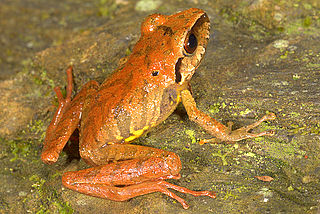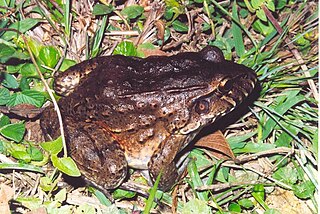
The Eleutherodactylidae are a family of direct-developing frogs native to northern South America, the Caribbean, and southernmost North America. They are sometimes known under the common name rain frogs. Formerly the subfamily Eleutherodactylinae of the family Leptodactylidae, it was raised to the family status following a major revision of New World direct-developing frogs in 2008. As currently defined, the family has more than 200 species.

The Cycloramphidae are a family of frogs endemic to southeastern Brazil. This family has seen large changes in its composition. Genera that have at some point been included in the Cycloramphidae are at present placed in the Alsodidae, Hylodidae, Leptodactylidae, and Rhinodermatidae. Of these, the Alsodidae and/or Hylodidae have also been considered as subfamilies of Cycloramphidae ; the Cycloramphidae, as recognized at present, would be similar to subfamily Cycloramphinae under such system.

Physalaemus is a large genus of leptodactylid frogs. These frogs, sometimes known as dwarf frogs or foam frogs, are found in South America. It is very similar to Leptodactylus, a close relative, and indeed the recently described Leptodactylus lauramiriamae is in some aspects intermediate between them.

Leptodactylus is a genus of leptodactylid frogs. It includes the species commonly called ditch frogs or white-lipped frogs. It is very similar to Physalaemus, a close relative, and indeed the 2005 described Leptodactylus lauramiriamae is in some aspects intermediate between them. The name means ‘slender finger’, from leptos and the Greek daktylos.
Ololygon alcatraz is a species of frog in the family Hylidae. It is endemic to Ilha dos Alcatrazes, an island off the coast of São Paulo state, Brazil. Common name Alcatraz snouted Treefrog has been coined for it.

Cycloramphus is a genus of frogs in the family Cycloramphidae. The genus is endemic to the southeastern Brazil. They are sometimes known as the button frogs.
Cycloramphus cedrensis is a species of frog in the family Cycloramphidae. It is endemic to southern Brazil and is only known from its type locality near Rio dos Cedros, Santa Catarina. Common name Cedros button frog has been coined for it.
Cycloramphus dubius is a species of frog in the family Cycloramphidae. It is endemic to the state of São Paulo, Brazil. Common name São Paulo button frog has been coined for it.
Cycloramphus izecksohni is a species of frog in the family Cycloramphidae. It is endemic to southern Brazil and occurs in the Serra do Mar in the states of Santa Catarina, Paraná, and São Paulo. Prior to its description in 1983, it was confused with Cycloramphus duseni. Common name Izecksohn's button frog has been coined for this species.
Cycloramphus mirandaribeiroi is a species of frog in the family Cycloramphidae. It is endemic to Brazil. Its natural habitats are subtropical or tropical moist lowland forests and rivers. Its population is in decline.

Cycloramphus stejnegeri is a species of frog in the family Cycloramphidae. It is endemic to the Serra dos Órgãos in southeastern Brazil. The specific name stejnegeri honors Leonhard Stejneger, a Norwegian–American herpetologist and ornithologist. Common name Stejneger's button frog has been coined for this species.

Hylodes is a genus of frogs in the family Hylodidae. The genus may be paraphyletic with respect to Megaelosia. The genus Hylodes is endemic to southeastern Brazil. Member species are also known commonly as the tree toads, or more ambiguously, as torrent frogs. They are diurnal and usually inhabit shallow mountain streams.
Hylodes uai is a species of frog in the family Hylodidae. It is endemic to the Espinhaço Mountains in the Minas Gerais state, Brazil, where it is known from the Mangabeiras Park in Belo Horizonte, and another location on the southern end of the Espinhaço Mountains. It is the most-inland species of the genus.

Leptodactylus labyrinthicus is a species of frog in the family Leptodactylidae. Its common names are labyrinth frog, pepper frog, South American pepper frog, and pepper foam frog. This frog is found in central and southeastern Brazil, northeast Argentina, and eastern Paraguay. Earlier reports from Bolivia refer to Leptodactylus vastus, or possibly an unnamed species.

Leptodactylus latrans is a species of frog in the family Leptodactylidae. It is native to much of South America east of the Andes, and Trinidad and Tobago. It has many common names, including rana criolla, sapo-rana llanero, butter frog, and lesser foam frog.

Leptodactylus podicipinus, sometimes known as the pointedbelly frog, is a species of frog in the family Leptodactylidae. It is found in northern Argentina, Paraguay, Uruguay, Bolivia, and Brazil.
Leptodactylus pustulatus is a species of frog in the family Leptodactylidae. It is endemic to Brazil. Its natural habitats are moist savanna, subtropical or tropical moist shrubland, freshwater marshes, pastureland, rural gardens, urban areas, and ponds. The female frog seems to provide some level of parental care for the tadpoles. This is a common species of frog and the International Union for Conservation of Nature has listed it as being of "least concern".
Thoropa saxatilis is a species of frog in the family Cycloramphidae. It is endemic to southern Brazil and occurs in the Santa Catarina and Rio Grande do Sul states, corresponding to the southernmost extent of the Atlantic Forest biome. The specific name saxatilis refers to its association with rocks. Common name Brazilian river frog has been coined for it.
Arthroleptides is a small genus of frogs in the family Petropedetidae. Their common name is rocky river frogs. They are found in the mountains of East Africa. They have been considered to belong to Petropedetes, which after exclusion of Arthroleptides is restricted to Central Africa.

Thoropa taophora, also known as the rock frog, is a species of frog in the family Cycloramphidae. These frogs are native to Brazil, where they inhabit the mountains and costal areas within the State of Sao Paolo. They are also one of many species to live in the great global diversity hotspot of the Brazilian Atlantic Forest.











